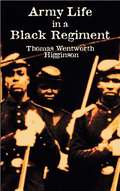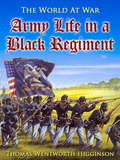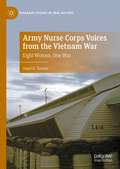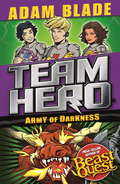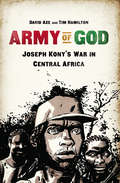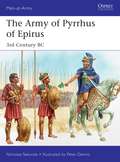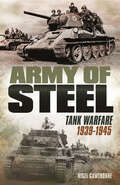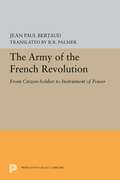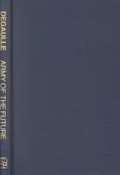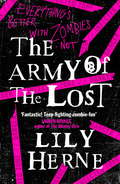- Table View
- List View
The Army in the Roman Revolution
by Arthur KeaveneyThe Roman Revolution is one of the most momentous periods of change in history, in which an imperial but quasidemocratic power changed into an autocracy. This book studies the way the Roman army changed in the last eighty years of the Republic, so that an army of imperial conquest became transformed into a set of rival personal armies under the control of the triumvirs. It emphasizes the development of what has often been regarded as a static monolithic institution, and its centrality to political change.
Army, Industry and Labour in Germany, 1914-1918
by Gerald FeldmanThis innovative study by one of the leading specialists in the field examines the social and economic role of the German army in the nation's internal affairs during the First World War. This was the area in which the influence of the army was most direct and profound. Germany's wartime economic mobilisation was both planned and directed by the army, and as a consequence of this largely unanticipated responsibility, the army was compelled to cope with the great social conflicts of Imperial Germany. In the process of confronting the groups representing army and labour, the army paved the way for the establishment of collective bargaining in Germany and also created the foundations for the postwar inflation.
Army, Industry and Labour in Germany, 1914-1918 (Legacy Of The Great War Ser.)
by Gerald FeldmanThis innovative study by one of the leading specialists in the field examines the social and economic role of the German army in the nation's internal affairs during the First World War. This was the area in which the influence of the army was most direct and profound. Germany's wartime economic mobilisation was both planned and directed by the army, and as a consequence of this largely unanticipated responsibility, the army was compelled to cope with the great social conflicts of Imperial Germany. In the process of confronting the groups representing army and labour, the army paved the way for the establishment of collective bargaining in Germany and also created the foundations for the postwar inflation.
'The Army Isn't All Work': Physical Culture and the Evolution of the British Army, 1860–1920
by James D. CampbellBetween the Crimean War and the end of the First World War the British Army underwent a dramatic change from being an anachronistic and frequently ineffective organization to being perhaps the most professional and highly trained army in the world. Historians have tended to view that transformation through the successive political reform efforts of those years, but have largely overlooked the ways in which the Army transformed itself from within. This change was effected through the modernization of training, operational and leadership doctrines. The adoption of formal physical training and organized games played a central part in this process. With its origins in elite public schools and upper-class country homes, the Army's philosophy of Athleticism was a part of the ethos of 'muscular Christianity' widely held in contemporary British institutions. Under the potent influence of this philosophy, military sport went from a means of keeping soldiers from drink and the officers from duty, to an institutionalized form of combat training. This book documents the origins and development of formal physical training in the late Victorian Army and the ways in which the Army's gymnastic training evolved into a vital building block of the process of turning a civilian into a fighting man. It also assesses the nature and extent of British military sport, particularly regimental sports, during this period of evolution for the Army. Through an investigation of the Army's physical culture during this dynamic period, one can gain an understanding of not only how the Army's change from within occurred, but also of some of the important links between the Army and its parent society.
'The Army Isn't All Work': Physical Culture and the Evolution of the British Army, 1860–1920
by James D. CampbellBetween the Crimean War and the end of the First World War the British Army underwent a dramatic change from being an anachronistic and frequently ineffective organization to being perhaps the most professional and highly trained army in the world. Historians have tended to view that transformation through the successive political reform efforts of those years, but have largely overlooked the ways in which the Army transformed itself from within. This change was effected through the modernization of training, operational and leadership doctrines. The adoption of formal physical training and organized games played a central part in this process. With its origins in elite public schools and upper-class country homes, the Army's philosophy of Athleticism was a part of the ethos of 'muscular Christianity' widely held in contemporary British institutions. Under the potent influence of this philosophy, military sport went from a means of keeping soldiers from drink and the officers from duty, to an institutionalized form of combat training. This book documents the origins and development of formal physical training in the late Victorian Army and the ways in which the Army's gymnastic training evolved into a vital building block of the process of turning a civilian into a fighting man. It also assesses the nature and extent of British military sport, particularly regimental sports, during this period of evolution for the Army. Through an investigation of the Army's physical culture during this dynamic period, one can gain an understanding of not only how the Army's change from within occurred, but also of some of the important links between the Army and its parent society.
Army Life in a Black Regiment (Civil War)
by Thomas Wentworth Higginson"Army Life in a Black Regiment has some claim to be the best written narrative to come from the Union [side] during the Civil War. Higginson's picture of the battle which was the origin of "praise the Lord and pass the ammunition" and his reading of the Emancipation Proclamation to the black regiment are unsurpassed for eloquence." — historian Henry Steele CommagerOriginally a series of essays, this important volume was written by a Union colonel from New England, in charge of African-American troops training on the Sea Islands off the coast of the Carolinas. A lively and detailed wartime diary, the book offers a refreshing portrait of life in the Union Army from an officer's point of view, recording opinions of other commanders and capturing the raw humor that develops among the men in combat. Higginson's descriptions of the soldiers, routines of camp life, and southern landscapes are unforgettable, as is the account of his near escape from a cannon ball. An unusual historical document intended to introduce new generations of readers to an American past that should not be forgotten, Army Life in a Black Regiment will be invaluable to students of Black History and the American Civil War.
Army Life in a Black Regiment (The World At War)
by Thomas Wentworth HigginsonThomas Wentworth Higginson (December 22, 1823 – May 9, 1911) was an American Unitarian minister, author, abolitionist, and soldier. He was active in the American Abolitionism movement during the 1840s and 1850s, identifying himself with disunion and militant abolitionism. He was a member of the Secret Six who supported John Brown. During the Civil War, he served as colonel of the 1st South Carolina Volunteers, the first federally authorised black regiment, from 1862–1864. Following the war, Higginson devoted much of the rest of his life to fighting for the rights of freed slaves, women and other disfranchised peoples. (Excerpt from Wikipedia)
Army movements at the Battle of Hastings in 1066 (Large Print)
by RnibThis diagram shows the movements of the opposing armies at the battle of Hastings in 1066. There is a locator dot shown, which will be at the top left of the page when the image is the right way up. There is a north arrow at the bottom right of the page, and a key in the bottom left that identifies the arrows used to show army movements.On the left of the page (to the north) stands Harold's army, on a ridge of land near to where the ruins of Battle Abbey now stand. King William's army is on the right side of the page, on a lower slope. It is made up of three units, the Flemings, Normans and Bretons. The battlefield is situated in the centre of the page.Initially the English exploited their excellent defensive position on the ridge, and their axmen and javelin throwers inflicted heavy losses. However, towards the end of the day after a long intense battle, some of William's army appeared to retreat (arrows A and B), enticing some of Harold's army to pursue them (arrows 1 and 2). This weakened the main body of the English army allowing the French to encircle them and eventually triumph. The site where Harold was believed to have been killed can now be visited in the ruins of the Abbey, which was built in the eleventh and thirteenth centuries.
Army movements at the Battle of Hastings in 1066 (large print)
by RnibThis diagram shows the movements of the opposing armies at the battle of Hastings in 1066. There is a locator dot shown, which will be at the top left of the page when the image is the right way up. There is a north arrow at the bottom right of the page, and a key in the bottom left that identifies the arrows used to show army movements.On the left of the page (to the north) stands Harold's army, on a ridge of land near to where the ruins of Battle Abbey now stand. King William's army is on the right side of the page, on a lower slope. It is made up of three units, the Flemings, Normans and Bretons. The battlefield is situated in the centre of the page.Initially the English exploited their excellent defensive position on the ridge, and their axmen and javelin throwers inflicted heavy losses. However, towards the end of the day after a long intense battle, some of William's army appeared to retreat (arrows A and B), enticing some of Harold's army to pursue them (arrows 1 and 2). This weakened the main body of the English army allowing the French to encircle them and eventually triumph. The site where Harold was believed to have been killed can now be visited in the ruins of the Abbey, which was built in the eleventh and thirteenth centuries.
Army movements at the Battle of Hastings in 1066 (UEB Contracted)
by RnibThis diagram shows the movements of the opposing armies at the battle of Hastings in 1066. There is a locator dot shown, which will be at the top left of the page when the image is the right way up. There is a north arrow at the bottom right of the page, and a key in the bottom left that identifies the arrows used to show army movements.On the left of the page (to the north) stands Harold's army, on a ridge of land near to where the ruins of Battle Abbey now stand. King William's army is on the right side of the page, on a lower slope. It is made up of three units, the Flemings, Normans and Bretons. The battlefield is situated in the centre of the page.Initially the English exploited their excellent defensive position on the ridge, and their axmen and javelin throwers inflicted heavy losses. However, towards the end of the day after a long intense battle, some of William's army appeared to retreat (arrows A and B), enticing some of Harold's army to pursue them (arrows 1 and 2). This weakened the main body of the English army allowing the French to encircle them and eventually triumph. The site where Harold was believed to have been killed can now be visited in the ruins of the Abbey, which was built in the eleventh and thirteenth centuries.
Army movements at the Battle of Hastings in 1066 (UEB contracted)
by RnibThis diagram shows the movements of the opposing armies at the battle of Hastings in 1066. There is a locator dot shown, which will be at the top left of the page when the image is the right way up. There is a north arrow at the bottom right of the page, and a key in the bottom left that identifies the arrows used to show army movements.On the left of the page (to the north) stands Harold's army, on a ridge of land near to where the ruins of Battle Abbey now stand. King William's army is on the right side of the page, on a lower slope. It is made up of three units, the Flemings, Normans and Bretons. The battlefield is situated in the centre of the page.Initially the English exploited their excellent defensive position on the ridge, and their axmen and javelin throwers inflicted heavy losses. However, towards the end of the day after a long intense battle, some of William's army appeared to retreat (arrows A and B), enticing some of Harold's army to pursue them (arrows 1 and 2). This weakened the main body of the English army allowing the French to encircle them and eventually triumph. The site where Harold was believed to have been killed can now be visited in the ruins of the Abbey, which was built in the eleventh and thirteenth centuries.
Army movements at the Battle of Hastings in 1066 (UEB Uncontracted)
by RnibThis diagram shows the movements of the opposing armies at the battle of Hastings in 1066. There is a locator dot shown, which will be at the top left of the page when the image is the right way up. There is a north arrow at the bottom right of the page, and a key in the bottom left that identifies the arrows used to show army movements.On the left of the page (to the north) stands Harold's army, on a ridge of land near to where the ruins of Battle Abbey now stand. King William's army is on the right side of the page, on a lower slope. It is made up of three units, the Flemings, Normans and Bretons. The battlefield is situated in the centre of the page.Initially the English exploited their excellent defensive position on the ridge, and their axmen and javelin throwers inflicted heavy losses. However, towards the end of the day after a long intense battle, some of William's army appeared to retreat (arrows A and B), enticing some of Harold's army to pursue them (arrows 1 and 2). This weakened the main body of the English army allowing the French to encircle them and eventually triumph. The site where Harold was believed to have been killed can now be visited in the ruins of the Abbey, which was built in the eleventh and thirteenth centuries.
Army movements at the Battle of Hastings in 1066 (UEB uncontracted)
by RnibThis diagram shows the movements of the opposing armies at the battle of Hastings in 1066. There is a locator dot shown, which will be at the top left of the page when the image is the right way up. There is a north arrow at the bottom right of the page, and a key in the bottom left that identifies the arrows used to show army movements.On the left of the page (to the north) stands Harold's army, on a ridge of land near to where the ruins of Battle Abbey now stand. King William's army is on the right side of the page, on a lower slope. It is made up of three units, the Flemings, Normans and Bretons. The battlefield is situated in the centre of the page.Initially the English exploited their excellent defensive position on the ridge, and their axmen and javelin throwers inflicted heavy losses. However, towards the end of the day after a long intense battle, some of William's army appeared to retreat (arrows A and B), enticing some of Harold's army to pursue them (arrows 1 and 2). This weakened the main body of the English army allowing the French to encircle them and eventually triumph. The site where Harold was believed to have been killed can now be visited in the ruins of the Abbey, which was built in the eleventh and thirteenth centuries.
Army Nurse Corps Voices from the Vietnam War: Eight Women, One War (Palgrave Studies in Oral History)
by Janet D. TannerThis book provides an oral history of women who served in the U.S. Army Nurse Corps during the Vietnam War. It follows the trajectory of eight women’s lives from their decision to become nurses, to surgical and evacuation hospitals in Vietnam, and then home to face the consequences of war on their personal and professional lives. It documents their lived experience in Vietnam and explores the memories and personal stories of nurses who treated injured American soldiers, Vietnamese civilians, and the enemy. Their voices reveal the physical and emotional challenges, trauma, contradictions, and lingering effects of war on their lives. Women in the U.S. Army in Vietnam feared the enemy but also sexual violence and harassment: the experiences this book documents also shed light on the extent of historical sexual abuse in the military.
Army of Darkness: Series 3 Book 3 (Team Hero #11)
by Adam BladeX-Men meets Beast Quest at the school for superheroes! An epic new adventure series from bestselling author Adam Blade - with amazing comic-book style illustrations. Team Hero Vs the world!Jack, Danny and Ruby must stop a powerful foe from regaining an ancient sceptre and unleashing its dark magic. But on their quest, they discover some new, unexpected enemies ...There are FOUR thrilling adventures to collect in this series - don't miss out!
Army of God: Joseph Kony's War in Central Africa
by David Axe Tim HamiltonJoseph Kony is the most dangerous guerilla leader in modern African history.It started with a visit from spirits. In 1991, Kony claimed that spiritual beings had come to him with instructions: he was to lead his group of rebels, the Lord's Resistance Army, in a series of brutal raids against ordinary Ugandan civilians. Decades later, Kony has sown chaos throughout Central Africa, kidnapping and terrorizing countless innocents—especially children. Yet despite an enormous global outcry, the Kony 2012 movement, and an international military intervention, the carnage has continued. Drawn from on-the-ground reporting by war correspondent David Axe and starkly illustrated by Tim Hamilton, Army of God is the first-ever graphic account of the global phenomenon surrounding Kony—from the devastation he has left behind to the long campaign to defeat him for good.
The Army of Northern Virginia (Men-at-Arms #37)
by Philip KatcherOn the 27 June, 1862, with the American Civil War already a year old, General Robert E. Lee assumed personal command of troops engaged in driving the Federal Army of the Potomac out of Richmond – troops which would henceforth be known as The Army of Northern Virginia. Philip Katcher explores in absorbing detail all aspects of the army, including infantry, cavalry, artillery, technical and medical corps, paying particular attention to equipment, weapons and uniforms. Contemporary and museum photographs, together with the author's expert text, combine to a paint a vivid and accurate picture of what life was like for the average confederate soldier.
The Army of Northern Virginia (Men-at-Arms)
by Michael Youens Philip KatcherOn the 27 June, 1862, with the American Civil War already a year old, General Robert E. Lee assumed personal command of troops engaged in driving the Federal Army of the Potomac out of Richmond – troops which would henceforth be known as The Army of Northern Virginia. Philip Katcher explores in absorbing detail all aspects of the army, including infantry, cavalry, artillery, technical and medical corps, paying particular attention to equipment, weapons and uniforms. Contemporary and museum photographs, together with the author's expert text, combine to a paint a vivid and accurate picture of what life was like for the average confederate soldier.
The Army of Pyrrhus of Epirus: 3rd Century BC (Men-at-Arms)
by Nicholas SekundaPyrrhus was one of the most tireless and famous warriors of the Hellenistic Age that followed the dispersal of Alexander the Great's brief empire. After inheriting the throne as a boy, and a period of exile, he began a career of alliances and expansion, in particular against the region's rising power: Rome. Gathering both Greek and Italian allies into a very large army (which included war-elephants), he crossed to Italy in 280 BC, but lost most of his force in a series of costly victories at Heraclea and Asculum, as well as a storm at sea. After a campaign in Sicily against the Carthaginians, he was defeated by the Romans at Beneventum and was forced to withdraw. Undeterred, he fought wars in Macedonia and Greece, the last of which cost him his life. Fully illustrated with detailed colour plates, this is the story of one of the most renowned warrior-kings of the post-Alexandrian age, whose costly encounters with Republican Rome have become a byword for victory won at unsustainable cost.
The Army of Pyrrhus of Epirus: 3rd Century BC (Men-at-Arms #528)
by Nicholas SekundaPyrrhus was one of the most tireless and famous warriors of the Hellenistic Age that followed the dispersal of Alexander the Great's brief empire. After inheriting the throne as a boy, and a period of exile, he began a career of alliances and expansion, in particular against the region's rising power: Rome. Gathering both Greek and Italian allies into a very large army (which included war-elephants), he crossed to Italy in 280 BC, but lost most of his force in a series of costly victories at Heraclea and Asculum, as well as a storm at sea. After a campaign in Sicily against the Carthaginians, he was defeated by the Romans at Beneventum and was forced to withdraw. Undeterred, he fought wars in Macedonia and Greece, the last of which cost him his life. Fully illustrated with detailed colour plates, this is the story of one of the most renowned warrior-kings of the post-Alexandrian age, whose costly encounters with Republican Rome have become a byword for victory won at unsustainable cost.
Army of Steel: Tank Warfare 1939-45
by Nigel Cawthorne'If the tanks succeed, then victory follows.'General Heinz Guderian, 1937When Germany attacked Poland on 1 September 1939, nothing like it had ever been seen before. Heralded by the insidious whine of Stuka divebombers, seven divisions of Panzers rolled across the border supported by motorized infantry.While tanks were punching gaping holes through Polish lines and racing on at speed towards Warsaw, fleeing refugees were machine-gunned mercilessly by the Luftwaffe and lines of communication were torn to ribbons as mayhem spread. This was Blitzkrieg (or 'lightning war'), the art of mechanized warfare.After seeing the success of the British tanks in the First World War, the Germans decided that the future of warfare lay in the Panzerkampfwagen, the armoured fighting vehicle, later simply known as the Panzer.Army of Steel: Tank Warfare 1939-45 explores the development of the Panzer concept, and the building and deployment of the Corps through the eyes of those who fought in it, and of those who fought against it. It tells the story of the singular breed of men who formed the spearhead of the world's most ruthless and efficient military machine, and how they ultimately came to be defeated.
The Army of the French Revolution: From Citizen-Soldiers to Instrument of Power (Princeton Legacy Library #5444)
by Jean Paul BertaudJean-Paul Bertaud is the leading French authority on the army of the French Revolution, and La Revolution armee is the authortative treatment of the firest great national, patriotic, revolutionary, and mass army, engaged in what has been called the first total war: that between revolutionary France and the other European powers. The book is a successful attempt to integrate military history with social and political history and thereby to depict the army as a "school for the republic" that by subtle changes after 1795 made way for the Napoleonic regime. The distinguished historian R.R. Palmer presents the first translation of this work into English in a volume that will quickly become indispensable for French historians, historical sociologists, and political scientists interested in armies and revolutions.The theme of the book is suggested by its French title: "the Revolution armed." That is, the book is primarily about the Revolution, and specifically the Revolution in its relation to armed force. This revolution, and this army, activated the idea of the citizen-soldier exemplified by the ancient classical republics, and favored by Jean-jacques Rousseau and other eighteenth-century thinkers, but never before realized on so large and portentous a scale as in France in the 1790s. Jean-Paul Bertaud is Professor of Modern History at the University of Paris I (the Sorbonne). He has published widely in France on aspects of the French Revolution. R.R. Palmer is Professor Emeritus at Yale University and author of numerous books, including the two-volume The Age of the Democratic Revolution (1959 and 1964), Twelve Who Ruled (1941), and The Improvement of Humanity: Education and the French Revolution (1985), all published by Princeton University Press. He has translated many works from the French, most recently The Two Tocquevilles, Father and Son: Herve and Alexis de TOcqueville on the Coming of the French Revolution (Princeton, 1987).Originally published in 1988.The Princeton Legacy Library uses the latest print-on-demand technology to again make available previously out-of-print books from the distinguished backlist of Princeton University Press. These editions preserve the original texts of these important books while presenting them in durable paperback and hardcover editions. The goal of the Princeton Legacy Library is to vastly increase access to the rich scholarly heritage found in the thousands of books published by Princeton University Press since its founding in 1905.
The Army of the Future (PDF)
by Charles De GaulleCharles de Gaulle's book The army of the future is the ground force version of Giulio Douhet's Command of the Air. de Gaulle describes what his vision of what mobile warfare would be in the future. He begins the book with a very interesting terrain analysis explaining why France has always been open to invasion. From there he describes what a division would look like containing two tank brigades, mechanized infantry, self propelled artillery, engineers, air defense, aviation and logistics. He also describes how these mobile divisions would fight. He explains what type of individuals would be needed to fill the ranks of this highly professional mobile army. My opinion that de Gaulle's vision is closer to the Heavy Divisions of the Cold war is based on de Gaulle calling for two Tank Brigades in his division while the German army of WWII had only one Panzer Regiment in their Panzer Divisions. Also the German Army relied heavily on horse transportation for most all of their artillery. A US Tank Division during the Cold War had two Tank and one Mechanized Infantry Brigade, all artillery was self propelled, this organization was more in line with de Gaulle's division than the Panzer Division was. That said, de Gaulle's vision for ground warfare was far more accurate than Douhet's vision for air power was.
The Army Of The Lost (Deadlands Quartet Ser.)
by Lily HerneOne of us is dead. One of us is broken. One of us will betray the others. And one of us will have to sell her soul to survive . . .It’s been eleven years since South Africa was ravaged by the walking dead. Johannesburg's impoverished survivors are ruled over by a minority of rich self-serving bureaucrats. As the remaining Mall Rats confront the dark heart of the twisted political system - in another part of town, Tommy dreams of joining the Army of the Left, a radical organisation intent on fighting for freedom.While Ash is forced to face his traumatic past, and Ginger struggles to regain his sanity; Lele goes head to head against a powerful foe, and Saint is dead set on a mission of her own: a fight for survival. Welcome back to the Deadlands . . .



